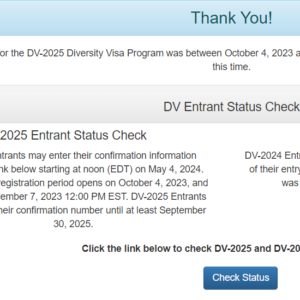DV 2020 – Halfway Down the Road

Starting an article with a reminder of something previously discussed kind of creates a link between where we left off and where we are at the moment. So here’s another one:
In this article, I kind of summarized “DV activities” in the year. Anyone who has read the article would be aware, not only of the two-month “cycles” around which the DV Program is built – allowing ample time for KCC and DV applicants to plan out their work and prepare for their interviews, respectively; but also of the fact that yesterday marked the halfway point into this fiscal year’s program as far as information regarding processing of cases is concerned.
Why does this matter?
January 31 is halfway into DV 2020 when counting from the beginning of August at which time processing of cases for the fiscal year actually begins. It corresponds to the date by which all applicants whose interviews have been planned for up to March 31 (halfway into the actual fiscal year) shall have received their NL2.
By the end of January, we’ve already been provided with six out of the total twelve visa bulletins containing information regarding DV processing for the fiscal year. And as such, I think it’s a good time to consider how things are going in this year’s Program.
Let’s make use of the tables below to observe and discuss monthly cut-offs by region.
Premise
But before we do, it’s important to understand that:
1. case numbers are only considered “high” or “low” when compared to others within the same region; a “low” case number in one region could be seen as “high” in another; and
2. (I believe this is even more important) “high” and “low” case number ranges have been “established” based on “tradition” and may not remain that way as time goes by.
Now let’s go on . . .
After the DV 2020 results were released last May, fear circulated among selectees with “high” case numbers who believed that those numbers would never become current. Some even considered simply taking their mind off DV 2020, while others panicked and went about asking what their chances were of getting interviewed.
Such agitations were “justified” owing to the fact that in recent years, having a “high” case number has generally led to thinking that so many entrants had been selected; and that a high such number stood a low chance of being interviewed.
For example, an applicant in the AF Region with a case number of AF55000 would not have been interviewed under normal circumstances during other recent DV programs.
However, such perception changed when the August 2019 VB was released a couple of months later which put the total number of selectees at 83,884, actually less than that of the previous year (87,610). An irony, isn’t it?
Those previously-disturbing “high” case numbers were thus discovered not to be the result of over selection. They simply meant that the overall case numbers selected were quite largely spaced out, thereby “pushing” the numbers selected further away from the lowest in their region. Those who got to understand that relaxed and allowed the process to take its course.
The tables below show cut-offs for the first half of Fiscal Year 2020, for each region.
I added a final column in each table which houses what has been considered high case numbers (HCN) in each region, for the sake of comparison. The + sign means “or greater”. Note that presently (as of March), each region is either very close to or has just passed previously-considered “high” case numbers.
You will also observe from the tables that the process started out pretty much “normally” in almost all regions. The cut-offs for the month of October 2019 were largely in tune with those from a year before. But before long, each region began to experience massive jumps, up to the halfway mark.
AFRICA
| FY | OCT | NOV | DEC | JAN | FEB | MAR | HCN |
| 2020 | 2,500; Except Egypt: 1,500 | 5,600 | 12,000 | 19,000; Except Egypt: 10,000 |
25,000; Except Egypt: 16,000 |
31,500; Except Egypt: 22,000 |
– |
| 2019 | 2750 | 6400 | 9800 | 13100 | 13800 | 15300 | 38,000+ |
Cut-offs for the AF Region remained “normal” for the first two months. The jumps in this region began as of December.
AMERICA, SOUTH and the CARIBBEAN
| FY | OCT | NOV | DEC | JAN | FEB | MAR | HCN |
| 2020 | 225 | 600 | 850 | 1,075 | 1,150 | 1,300 |
– |
| 2019 | 150 | 355 | 475 | 550 | 625 | 750 | 1,200+ |
The SA Region was the only that showed some initial sign of an “abnormal” cut-off. It’s jumps started right from the beginning.
Jumps in the remaining three regions began to be experienced from the month of November as indicated by their respective tables.
ASIA
| FY | OCT | NOV | DEC | JAN | FEB | MAR | HCN |
| 2020 | 1,300; Except Iran:750, Nepal: 1,000 | 3,500 | 6,000 | 8,200; Except Iran: 5,100; Nepal: 6,500 | 12,000; Except Iran: 6,500 Nepal: 7,575 |
12,500; Except Iran: 7,600 Nepal: 8,800 |
– |
| 2019 | 1000 | 1600 | 2900 | 3800 | 4400 | 5000 |
11,000+ |
EUROPE
| FY | OCT | NOV | DEC | JAN | FEB | MAR | HCN |
| 2020 | 2,100 | 6,000 | 8,600 | 10,300 | 14,000 | 21,000 |
– |
| 2019 | 2000 | 4400 | 6600 | 8800 | 10000 | 13500 | 26,000+ |
OCEANIA
| FY | OCT | NOV | DEC | JAN | FEB | MAR | HCN |
| 2020 | 175 | 400 | 800 | 1,200 | 1,350 | 1,625 |
– |
| 2019 | 100 | 200 | 290 | 350 | 450 | 550 | 1,100+ |
Interpretations
Some have interpreted these jumps as either KCC speeding up the application process, or possibly interviewing so many applicants on a monthly basis. But that’s not the case. There’s no speeding up here; KCC are not rushing the interviews to get to high case numbers. Interview pace is quite normal, and average monthly interviews are about the same as in recent years.
And even at that, interviews will still be conducted for most of those whose case numbers were initially thought to have been high. That’s because firstly, and as indicated above, there wasn’t an over-selection of entrants.
And secondly – a quite recent occurrence – a number of eligible countries have just been hit by an expanded U.S. travel ban which comes into effect later this month. As such, those who are not from the countries affected have more reason to hope and not be alarmed, even if they have a high DV 2020 case number.
This however does not in any way mean that all applicants will be interviewed, let alone obtain a DV.
What the recent VB progression actually means
The high case numbers and consequent “jumps” in monthly cut-offs only indicate a shift in the low-high case number ranges previously established. And it is quite too early to know whether this shift is temporal or long-lasting.
As I mentioned in a number of past articles, monthly cut-offs usually remain within the same range for a certain period until there’s a major procedural change in how processing is carried out.
Conclusion
This year’s spacing out of case numbers is for sure the result of a change within the workings of KCC. We however do not know whether said change is a major or minor one. But what we can be sure of is this: if it’s a minor change, we will return to the “normal” Visa Bulletin progression that we’ve come to know over recent years.
If, on the other hand, it’s the result of a more structural change with stronger effects, case numbers that currently appear as being high may henceforth be considered quite normal in their region.
In this lies the particularity of the DV Lottery: in its ever-changing environment, outcomes are quite difficult to foresee.


